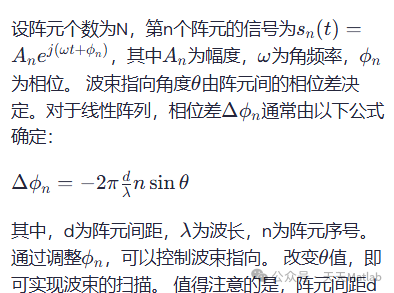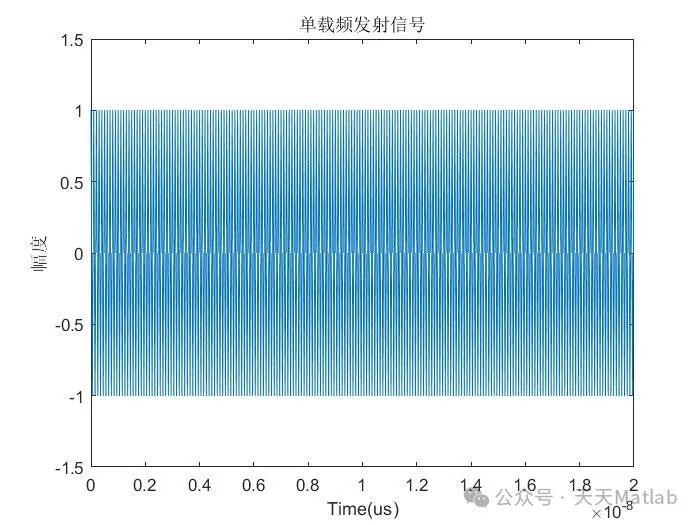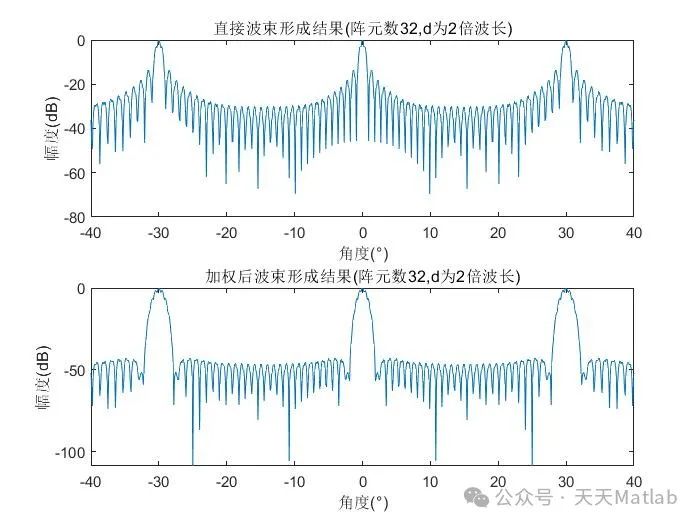✅ Author Introduction: A Matlab simulation developer passionate about research, skilled in data processing, modeling and simulation, program design, acquiring complete code, reproducing papers, and scientific simulations.
🍎 Personal Homepage:Matlab Research Studio
🍊 Personal Motto: Seek knowledge through investigation; feel free to DM for help.
🔥 Content Introduction
As a core component of modern radar systems, radar phased array technology’s key lies in beamforming technology. Phased array radar achieves rapid and flexible scanning and control of beams by controlling the phase and amplitude of numerous array elements. Compared to traditional mechanical scanning radars, it exhibits significant advantages. This article will delve into the technical principles, algorithm implementations, and application prospects of radar phased array beamforming, and will also look ahead to future development directions.
1. Basic Principles of Phased Array Radar Beamforming
The core of phased array radar is the orderly arrangement of numerous unit antennas (array elements). Each array element has independent phase and amplitude control capabilities for the signals it receives or transmits. By precisely controlling the phase delays of each array element, the electromagnetic waves emitted by the elements can constructively interfere in a specific direction in space, thus forming a beam directed towards that specific direction. Conversely, due to the phase differences, signals will interfere destructively in other directions, achieving directional transmission and reception of the beam.

Apart from phase control, amplitude control is also crucial for beamforming. By adjusting the amplitude of each array element, the shape of the beam can be altered, for instance, to form beams with specific sidelobe levels or specific radiation patterns, such as Taylor windows and Chebyshev windows. These window functions can effectively suppress sidelobes and improve beam pointing accuracy.
2. Beamforming Algorithms
The key to achieving beamforming lies in the beamforming algorithms. Commonly used beamforming algorithms include:
-
Delay-and-Sum: This is the simplest beamforming algorithm, which forms beams by appropriately delaying each array element’s signal and then summing them. This method is easy to compute but has weak anti-jamming capability and lower resolution.
-
Minimum Variance Distortionless Response (MVDR): The MVDR algorithm minimizes output noise power while maintaining a distortionless response to the desired signal. This algorithm has better anti-jamming capability and resolution, but its computational complexity is relatively high.
-
Adaptive Beamforming Algorithms: This class of algorithms can adaptively adjust beam weights based on the received signals to achieve optimal performance. Common adaptive beamforming algorithms include LMS and RLS algorithms. These algorithms can effectively suppress interference and improve the signal-to-noise ratio, but they have relatively high computational complexity and require high real-time processing capabilities.
-
Space-Time Adaptive Processing (STAP): The STAP algorithm considers information from both spatial and temporal domains, effectively suppressing clutter and interference, thereby enhancing radar detection performance, especially in complex electromagnetic environments.
3. Applications of Phased Array Radar Beamforming
The beamforming technology of phased array radar has been widely applied in various fields:
-
Military Radar: Phased array radar plays an extremely important role in the military field, including early warning radar, fire control radar, and guidance radar. Its capabilities for rapid scanning, multi-target tracking, and electronic countermeasures greatly enhance the combat effectiveness of military equipment.
-
Weather Radar: Phased array weather radar can quickly scan the atmosphere, providing high-resolution meteorological data and improving the accuracy of weather forecasts.
-
Civilian Radar: In the civilian sector, phased array radar is applied in air traffic control, maritime navigation, and vehicle-assisted driving.
-
Medical Imaging: Phased array technology is also used in medical imaging fields, such as ultrasound imaging, to improve imaging quality and resolution.
4. Future Development Prospects
The future development trends for phased array radar beamforming technology mainly include:
-
Large-Scale Arrays: With advancements in integrated circuit technology, large-scale array phased array radar will become a development trend, further improving radar resolution, sensitivity, and anti-jamming capabilities.
-
New Beamforming Algorithms: Researching more efficient and robust beamforming algorithms, such as deep learning-based beamforming algorithms, to adapt to increasingly complex electromagnetic environments.
-
Multi-Functional Beamforming: Achieving flexible control of beams, such as simultaneously forming multiple beams for multi-target tracking and multifunctional detection.
-
Digital Beamforming: Digital beamforming technology can provide greater flexibility and programmability, making it an important direction for future development.
⛳️ Operating Results


🔗 References
🎈 Some theories cited from online literature; please contact the author for removal if there are any infringements.
👇 Follow me for a wealth of Matlab e-books and mathematical modeling materials.
🎁 DM for complete code and data acquisition as well as paper modeling and simulation customization.
🌿 For past reviews, feel free to check the homepage and click search.
🏆 Our team excels in guiding customized MATLAB simulations across various research fields to support your research dreams:
🌈 Various intelligent optimization algorithm improvements and applications
Production scheduling, economic scheduling, assembly line scheduling, charging optimization, workshop scheduling, departure optimization, reservoir scheduling, 3D packing, logistics site selection, cargo space optimization, bus scheduling optimization, charging station layout optimization, workshop layout optimization, container ship loading optimization, pump combination optimization, medical resource allocation optimization, facility layout optimization, visual domain base station and drone site selection optimization, knapsack problem, wind farm layout, time slot allocation optimization, optimal distributed generation unit allocation, multi-stage pipeline maintenance, factory-center-demand point three-level location problem, emergency supply distribution center site selection, base station site selection, road lamp post arrangement, hub node deployment, transmission line typhoon monitoring devices, container scheduling, unit optimization, investment portfolio optimization, cloud server combination optimization, antenna linear array distribution optimization, CVRP problem, VRPPD problem, multi-center VRP problem, multi-layer network VRP problem, multi-center multi-vehicle VRP problem, dynamic VRP problem, two-layer vehicle routing planning (2E-VRP), electric vehicle routing planning (EVRP), hybrid vehicle routing planning, mixed flow shop problem, order splitting scheduling problem, bus scheduling optimization problem, flight shuttle vehicle scheduling problem, location path planning problem, port scheduling, port bridge scheduling, parking space allocation, airport flight scheduling, leakage source localization.
🌈 Machine learning and deep learning time series, regression, classification, clustering, and dimensionality reduction
2.1 BP time series, regression prediction, and classification
2.2 ENS voice neural network time series, regression prediction, and classification
2.3 SVM/CNN-SVM/LSSVM/RVM support vector machine series time series, regression prediction, and classification
2.4 CNN|TCN|GCN convolutional neural network series time series, regression prediction, and classification
2.5 ELM/KELM/RELM/DELM extreme learning machine series time series, regression prediction, and classification
2.6 GRU/Bi-GRU/CNN-GRU/CNN-BiGRU gated neural network time series, regression prediction, and classification
2.7 Elman recurrent neural network time series, regression prediction, and classification
2.8 LSTM/BiLSTM/CNN-LSTM/CNN-BiLSTM long short-term memory neural network series time series, regression prediction, and classification
2.9 RBF radial basis neural network time series, regression prediction, and classification
2.10 DBN deep belief network time series, regression prediction, and classification
2.11 FNN fuzzy neural network time series, regression prediction
2.12 RF random forest time series, regression prediction, and classification
2.13 BLS broad learning system time series, regression prediction, and classification
2.14 PNN pulse neural network classification
2.15 fuzzy wavelet neural network prediction and classification
2.16 Time series, regression prediction, and classification
2.17 Time series, regression prediction, and classification
2.18 XGBOOST ensemble learning time series, regression prediction, and classification
2.19 Transform various combinations of time series, regression prediction, and classification
Directions cover wind power prediction, photovoltaic prediction, battery life prediction, radiation source identification, traffic flow prediction, load prediction, stock price prediction, PM2.5 concentration prediction, battery health status prediction, electricity consumption prediction, water body optical parameter inversion, NLOS signal identification, subway parking precise prediction, transformer fault diagnosis.
🌈 Image processing aspects
Image recognition, image segmentation, image detection, image hiding, image registration, image stitching, image fusion, image enhancement, image compressed sensing.
🌈 Path planning aspects
Traveling salesman problem (TSP), vehicle routing problem (VRP, MVRP, CVRP, VRPTW, etc.), UAV 3D path planning, UAV cooperation, UAV formation, robot path planning, grid map path planning, multimodal transport problems, electric vehicle routing planning (EVRP), two-layer vehicle routing planning (2E-VRP), hybrid vehicle routing planning, vessel trajectory planning, full path planning, warehouse patrol.
🌈 UAV application aspects
UAV path planning, UAV control, UAV formation, UAV cooperation, UAV task allocation, UAV safe communication trajectory online optimization, vehicle cooperative UAV path planning.
🌈 Communication aspects
Sensor deployment optimization, communication protocol optimization, routing optimization, target localization optimization, Dv-Hop localization optimization, Leach protocol optimization, WSN coverage optimization, multicast optimization, RSSI localization optimization, underwater communication, communication upload/download allocation.
🌈 Signal processing aspects
Signal recognition, signal encryption, signal denoising, signal enhancement, radar signal processing, signal watermark embedding and extraction, EMG signals, EEG signals, signal timing optimization, ECG signals, DOA estimation, encoding and decoding, variational modal decomposition, pipeline leakage, filters, digital signal processing + transmission + analysis + denoising, digital signal modulation, bit error rate, signal estimation, DTMF, signal detection.
🌈 Power system aspects
Microgrid optimization, reactive power optimization, distribution network reconstruction, energy storage configuration, orderly charging, MPPT optimization, household electricity.
🌈 Cellular automata aspects
Traffic flow, crowd evacuation, virus spread, crystal growth, metal corrosion.
🌈 Radar aspects
Kalman filter tracking, trajectory association, trajectory fusion, SOC estimation, array optimization, NLOS identification.
🌈 Workshop scheduling
Zero-wait flow shop scheduling problem (NWFSP), permutation flow shop scheduling problem (PFSP), hybrid flow shop scheduling problem (HFSP), zero idle flow shop scheduling problem (NIFSP), distributed permutation flow shop scheduling problem (DPFSP), blocking flow shop scheduling problem (BFSP).
👇